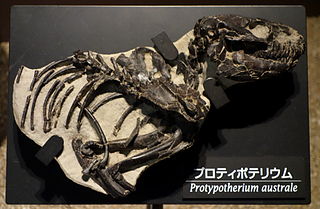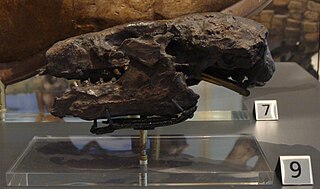
Theosodon is an extinct genus of litoptern mammal from the Early to Middle Miocene of South America.

Protypotherium is an extinct genus of notoungulate mammals native to South America during the Oligocene and Miocene epochs. A number of closely related animals date back further, to the Eocene. Fossils of Protypotherium have been found in the Deseadan Fray Bentos Formation of Uruguay, Muyu Huasi and Nazareno Formations of Bolivia, Cura-Mallín and Río Frías Formations of Chile, and Santa Cruz, Salicas, Ituzaingó, Aisol, Cerro Azul, Cerro Bandera, Cerro Boleadoras, Chichinales, Sarmiento and Collón Curá Formations of Argentina.
Chasicotherium is an extinct genus of a large notoungulate mammal known originally from a partial skull and mandible discovered in the Arroyo Chasicó Formation, in the stream of Party of Villarino, Buenos Aires, Argentina. The sediments in which the animal was discovered dates to 10 to 9 million years (Chasicoan). It is known only from the type species, C. rothi. Its weight was approximately 1 tonne, being the largest and most recent member of the family Homalodotheriidae. It was a large herbivore of the Miocene Pampas, closely related to Homalodotherium, which also shares the reduced dental formula of the short premaxilla.

Mesotheriidae is an extinct family of notoungulate mammals known from the Oligocene through the Pleistocene of South America. Mesotheriids were small to medium-sized herbivorous mammals adapted for digging.
The Chasicoan age is a period of geologic time from 10–9 Ma within the Late Miocene epoch of the Neogene, used more specifically within the SALMA classification in South America. It follows the Mayoan and precedes the Huayquerian age.
The Huayquerian age is a period of geologic time within the Late Miocene epoch of the Neogene, used more specifically within the SALMA classification. It follows the Chasicoan and precedes the Montehermosan age.

Hegetotherium is an extinct genus of mammals from the Early to Middle Miocene of South America. Fossils of this genus have been found in the Cerro Bandera, Cerro Boleadoras, Chichinales, Collón Curá, Santa Cruz and Sarmiento Formations of Argentina, the Nazareno Formation of Bolivia, and the Galera and Río Frías Formations of Chile.
The Colorado Basin is a sedimentary basin located in northeastern Patagonia. The basin stretches across an area of approximately 180,000 square kilometres (69,000 sq mi), of which 37,000 square kilometres (14,000 sq mi) onshore in the southern Buenos Aires Province and the easternmost Río Negro Province extending offshore in the South Atlantic Ocean.

The Cerro Azul Formation, also described as Epecuén Formation, is a geological formation of Late Miocene age in the Colorado Basin of the Buenos Aires and La Pampa Provinces in northeastern Argentina.
Kelenkura is an extinct genus of heavily armored mammals belonging to the subfamily Glyptodontinae, from the family Chlamyphoridae that contain most of the modern armadillos. It was a medium-sized South American animal, distantly related to Doedicurus. Fossils of this genus were recovered in the Arroyo Chasicó Formation and in the Loma de Las Tapias Formation of Argentina in rocks dating back to the Late Miocene epoch.
Paratrigodon is an extinct genus notoungulate belonging to the subfamily Toxodontinae, containing one species, P. euguii. Like its close relative Trigodon, it is known for the presence of a horn-like protuberance on its forehead. Fossils of Paratrigodon are known from the Arroyo Chasicó Formation dating from the Chasicoan period, and teeth from the Laventan-aged Quebrada Honda Fauna of Bolivia were also associated with the genus, although considered too different from the type species to be assigned to it.

Paedotherium is an extinct, potentially paraphyletic genus of Notoungulate, belonging to the family Hegetotheriidae, composed of small-sized, rodent or lagomorph-like South American ungulates. Four species are unambiguously recognized, from the Late Miocene to the Pleistocene of Argentina, and from the late Miocene of Bolivia and Chile.
Cullinia is an extinct genus of litoptern, an order of South American native ungulates that included horse-like and camel-like animals such as Macrauchenia. It is only known from fragmentary remains. Cullinia levis is known from Chasicoan remains found in the Arroyo Chasicó Formation of Argentina, and remains from the Brazilian state of Acre and the Huayquerian Ituzaingó Formation have been assigned to Cullinia sp..
Promacrauchenia is an extinct genus of macraucheniids that lived during the Late Miocene to Late Pliocene epochs of what is now Argentina and Bolivia. It belongs to the subfamily Macraucheniinae, which also includes Huayqueriana, Macrauchenia, and Xenorhinotherium. Fossils of this genus have been found in the Ituzaingó, Andalhuala, and Cerro Azul Formations of Argentina.

Tremacyllus is an extinct genus of hegetotheriids. It lived from the Late Miocene to the Late Pleistocene and its fossilized remains were discovered in South America.
Eoauchenia is a genus of extinct proterotheriid from the Late Miocene and Early Pliocene of Argentina. The genus was named by Ameghino in 1887 for the type species E. primitiva, which was originally known from the early Pliocene Monte Hermoso Formation of the Montehermosan age of Buenos Aires Province, but has since been found in the Cerro Azul Formation of the late Huayquerian of La Pampa Province. The fossils originally known included postcranial remains like foot material, but teeth, a skull and skeleton, and mandibles and further postcrania have since been referred to Eoauchenia, which can be distinguished from Epitherium found alongside it by more gracile bones.

Proscelidodon is an extinct genus of ground sloths in the family Scelidotheriidae. It lived during the Miocene and Pliocene of what is now Argentina and Bolivia. The genus was described in 1935.
Hegetotheriopsis is an extinct genus of hegetotheriid notoungulate. It lived from the Late Oligocene to the Early Miocene, and its fossilized remains are found in Argentina.
Chasicobradys is an extinct genus of ground sloths of the family Nothrotheriidae that lived in what is now Argentina. Chasicobradys was discovered in the Arroyo Chasicó Formation, in Buenos Aires Province. It is only known from jaw fragments and teeth, which allowed the identification of this species, and was classified as a member of the nothrotheriid subfamily Nothrotheriinae, which comprises small to medium-sized species of ground sloths.
Bondesiomys is an extinct genus of dinomyid rodent that inhabited Argentina during the Late Miocene. It is a monotypic genus containing the species B. chasiquensis.















